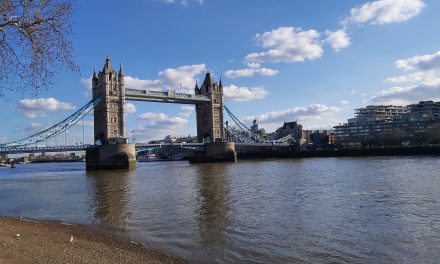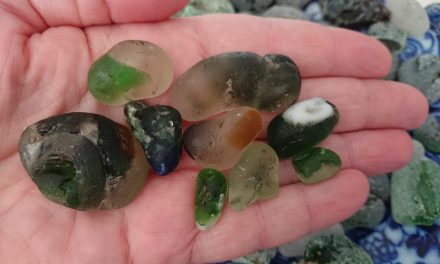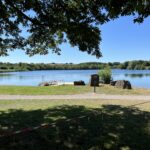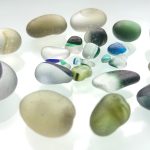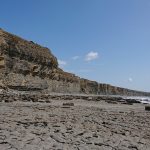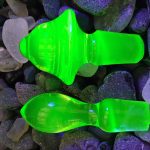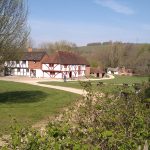Although we live in the city (in the centre of Cardiff) we are lucky to be within half an hour drive of the nearest beach. One of my favourite places to go beachcombing is in sully. We like to go to a place called St Mary’s Well Bay. It is just around the coast from Sully island next to Lavernock.
Access to the beach can be achieved either by parking in the captain’s wife and walking from Swanbridge beach up and over the rocks (which I’ve never been able to do because they are pretty large) or walking down the St Mary’s Well Bay Road and through the forestry. There are also a couple of laybys on that road that you can park, but your best bet is to park in the captain’s wife and walk down the road.
There are some muddy paths leading off the road through the forestry (after the largest layby); follow the path through the forestry, and you will come out near a derelict house. To the front of that house is a bunker, and by the side of that, there are a few simple man-made steps going down onto the beach.
If you are unsteady on your feet, I don’t recommend visiting this beach as the access is not great. The man-made steps are in about a three-foot bank which is basically just stones pushed into the mud. This beach also has lots of rocks to walk over before you get to the shingle (which is where the best finds are).
There is also access to the beach from the caravan park down the cliff face, but I’ve never used it, and it does seem a little more treacherous than the way we go in, also I’m not sure if there is parking there.
This stretch of coast is absolutely littered with history, from convoys of ships transporting goods in and out of the UK and also remnants of the war. I can’t even tell you how many ships have sunk in that stretch of coast, so there is always something to find there.
What to expect from our article
Sully Island
Sully Island has its very own shipwreck that is visible from the island. Access to the island is from the car park at the captain’s wife pub in Swanbridge. There used to be a charge for parking at the Captain’s Wife, but now parking is free. Access to the island itself can only be achieved at low tide; when the tide goes out, it reveals a pathway over to the island.
Great care should be taken when visiting the island because when the tide comes back in, it completely cuts off the path; there is no way of getting back for 12 hours. Many have tried, but sadly lives have been lost in the process.
Due to the number of people visiting the island and becoming stranded, they have now installed a traffic light system telling you when it is safe to cross. There is around a three-hour window for visiting, so this should give you plenty of time to explore.
The island itself is 14 and a half acres, and you can walk around it; the views are spectacular from the island, so it is well worth a visit if you have never been before. The shipwreck is located at the front of the island (facing the captain’s wife). It’s a little slippery around the wreckage as there is a fair amount of mud, but it is something special, at least I think it is. There were many shipwrecks at Sully Island, so it isn’t known which wreck it actually is, but It was rumoured to have been the Sy Scotia; the wreck is said to be too small to be that particular ship.
Swanbridge History
Swanbridge was used as a harbour for many, many years transporting goods to the market in Canton in Cardiff. Historical records show that in order to bring items ashore, you needed to pay import fees; many people tried to avoid paying these fees and instead tried to smuggle their goods ashore instead.
In 1569 court records revealed that harbour officials seized a considerably large amount of butter and cheese that was brought ashore by smugglers. It is also said that there was a tunnel from the island to the captain’s wife and a secret room to store their smuggled goods in; I’m not sure how much of that is true, though.
Later in 1658, the harbour was not only being used to smuggle in goods, but it was also being used to smuggle in people, illegal immigrants or as they were known locally, “undesirables”. In 1977/76, the row of cottages that probably housed local fishermen was converted into what we know now as the captain’s wife pub.
Lavernock
Lavernock is also steeped in history with its 1860/70 gun battery, with its three 7” muzzleloading cannons; a fourth gun was added later, and then all four were upgraded with two rapid-fire former naval guns. Lavernock formed part of a larger coastal sea defence protecting Cardiff, barry and flat holm; Lavernock defended Cardiff and Bristol.
The battery was a triangular-shaped structure with four gun emplacements; it also had a protective ditch, a magazine and a laboratory. Today most of the battery has been destroyed and the ditch filled in. a swimming pool now sits over one of the magazines and what remains of the battery is now within the holiday park.
Lavernock Fossils
These days, Lavernock is well known for its fossils; the site has a mixture of Jurassic and Triassic rocks that yield ammonites, molluscs, and fish and reptile remains. In 2015 the skeleton of a new species of dinosaur called the dracoraptor was discovered at lavernock. The dog-sized theropod dinosaur skeleton is believed to be the earliest known Jurassic dinosaur.
Be aware when visiting lavernock that it is a protected site, and while it’s ok to crack open a few rocks lying on the beach or take away any fossils lying on the ground, you are not allowed to remove them from the bedrock itself. I haven’t actually visited Lavernock myself, so I think it is one to be added to the list of beaches I must visit.



